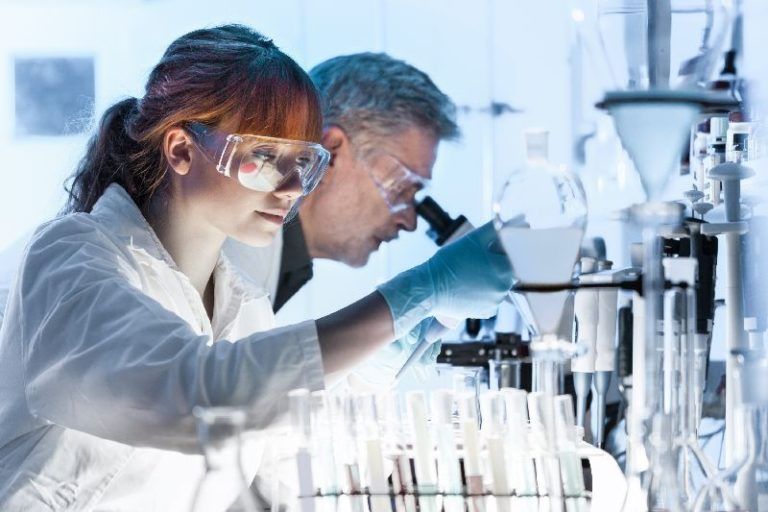
Initiative could deliver breakthrough technology for drug discovery platforms
- This project was covered by BBC Scotland in December 2015
Medical researchers could better understand the effects of drugs on cancerous cells and the development of stem cells, as the result of a pioneering collaborative Scottish research project.
The initiative, involving CENSIS, Biogelx Limited and the Centre for Nanometrology at the University of Strathclyde, will allow scientists to examine how stem cells grow and behave in conditions much closer to their natural environment, i.e. in different parts of the human anatomy.
For the most part, cell cultures are currently analysed in a 2D format, commonly on a petri-dish or other flat surfaces, which doesn’t encourage them to grow in the same way they would in the body.
However, with the use of Biogelx’s ‘tuneable’ peptide gels1 and the University of Strathclyde’s sophisticated Raman Spectroscopy2 capabilities, researchers could gain access to a more accurate, three-dimensional understanding of how cells naturally develop and grow in the body.
Eventually, this new approach could be employed to study the effects of drug candidates on key disease models.
The project will also aim to understand how stem cells can be influenced to develop specific tissue types and how human tissue can be regrown in a controlled and pre-determined manner. The ultimate goal will be to push cells towards developing into the tissue required to regenerate particular organs, or parts of the body, after illness.
Eleanore Irvine, Business Development Manager at Biogelx, said: “Stem cell technologies have been a hot topic in recent years. The more that scientists understand exactly what cues, environments and chemistries influence a stem cell to grow into different types of cell, like brain, bone or liver, the closer we come to being able to artificially design human tissue or harness the power of stem cells to self-repair the body. Our project will design a platform that will both influence stem cell growth into specific cell-types and help us understand what the development path for the stem cell looks like.
“This will open up a whole world of insight. Knowing how cell cultures react and behave in these environments will help us comprehend how we can encourage stem cells to differentiate and grow into the right kind of tissue. What’s more, our technique has the potential for use in high throughput screening of drug candidates, as a method to more accurately determine how pharmaceuticals affect specific cells and organs before they are applied in clinical trials.”
The project will focus on the development of a bio-imaging platform using the University of Strathclyde’s Raman Spectroscopy analysis capabilities, which provide a minimally invasive way of analysing cell cultures. Using light much higher in the spectrum compared with other techniques, the tool allows for greater accuracy during tests.
Professor Duncan Graham, Research Chair of Chemistry at the Department of Pure and Applied Chemistry at the University of Strathclyde, added: “In a lot of cases, the techniques used to analyse how cells react to different drug therapies and how stem cells develop naturally, are quite intrusive. They often require fluorescent markers, dyes added to the cell cultures, and light at wavelengths that can cause damage.
“But our analytical tool removes this issue by using longer wavelength light and minimising invasiveness. It means we can better understand how cells in different parts of the human body organically react to a variety of stimuli.”
The tissue engineering and regenerative medicine market was estimated to be worth $25 billion last year and is expected to grow at a rate of 20% per annum. As the product is commercialised, Biogelx will target the hydrogels sub-sector in the overall market; a $3 billion opportunity.
CENSIS is providing project management support and £49,489 of funding for the initiative. It will be the first project it has supported which uses a biological sensor.
Dr Diana Morgan, Business Development Manager at CENSIS, commented: “This research demonstrates the near-universal potential application of sensor and imaging technology. Its ability to help deliver breakthroughs in a variety of fields, including life sciences, is almost unparalleled.
“Biogelx and the University of Strathclyde are at the forefront of research in their respective areas – this latest initiative demonstrates the ground breaking talent Scotland has in both its business and academic communities. Through their combined endeavour, they have the ability to solve some of the biggest health challenges of our time through world-leading technology.”
- About tuneable peptide gels
Biogelx’s tuneable peptide gels are synthetically produced as a nano-fibrous matrix, which can be controlled to create more realistic conditions for cell growth. The structure can be modified, according to the conditions researchers are looking to recreate, and allows cell development to take place in a 3D environment.
- About Raman Spectroscopy
Raman Spectroscopy is used to understand what materials are made of. The technique involves shining a monochromatic light source on a sample and detecting the scattered light.